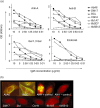Natural human antibodies to pneumococcus have distinctive molecular characteristics and protect against pneumococcal disease
- PMID: 17983446
- PMCID: PMC2276916
- DOI: 10.1111/j.1365-2249.2007.03535.x
Natural human antibodies to pneumococcus have distinctive molecular characteristics and protect against pneumococcal disease
Abstract
The molecular and functional characteristics of natural antibody from the preimmune repertoire have not been explored in detail in man. We describe seven human IgM monoclonal antibodies selected on the basis of pneumococcal polysaccharide binding that share both molecular and functional characteristics with natural antibody, suggesting a common B cell lineage origin. Unlike class-switched antibodies, which are serotype-specific, the antibodies were polyreactive and bound all pneumococcal polysaccharide capsular serotypes tested. Some bound endogenous antigens, including blood group antigens and intermediate filament proteins. All the antibodies used unmutated heavy chain V (IGHV) that are expressed at an increased frequency in the elderly and in the preimmune repertoire. The CDR3 was characterized by long length (mean aa 18.4 (+/-4.2) and selective use of IGHD6 (P < 0.001) and IGHJ6 (P < 0.01) family genes. The clones expressing IGHV1-69 and IGHV 3-21 provided significant passive protection against invasive pneumococcal disease in vivo.
Figures




References
-
- Martin F, Kearney JF. B-cell subsets and the mature preimmune repertoire. Marginal zone and B1 B cells as part of a ‘natural immune memory’. Immunol Rev. 2000;175:70–9. - PubMed
-
- Boes M. Role of natural and immune IgM antibodies in immune responses. Mol Immunol. 2000;37:1141–9. - PubMed
-
- Baker N, Ehrenstein MR. Cutting edge: selection of B lymphocyte subsets is regulated by natural IgM. J Immunol. 2002;169:6686–90. - PubMed
Publication types
MeSH terms
Substances
Grants and funding
LinkOut - more resources
Full Text Sources
Other Literature Sources
Medical

